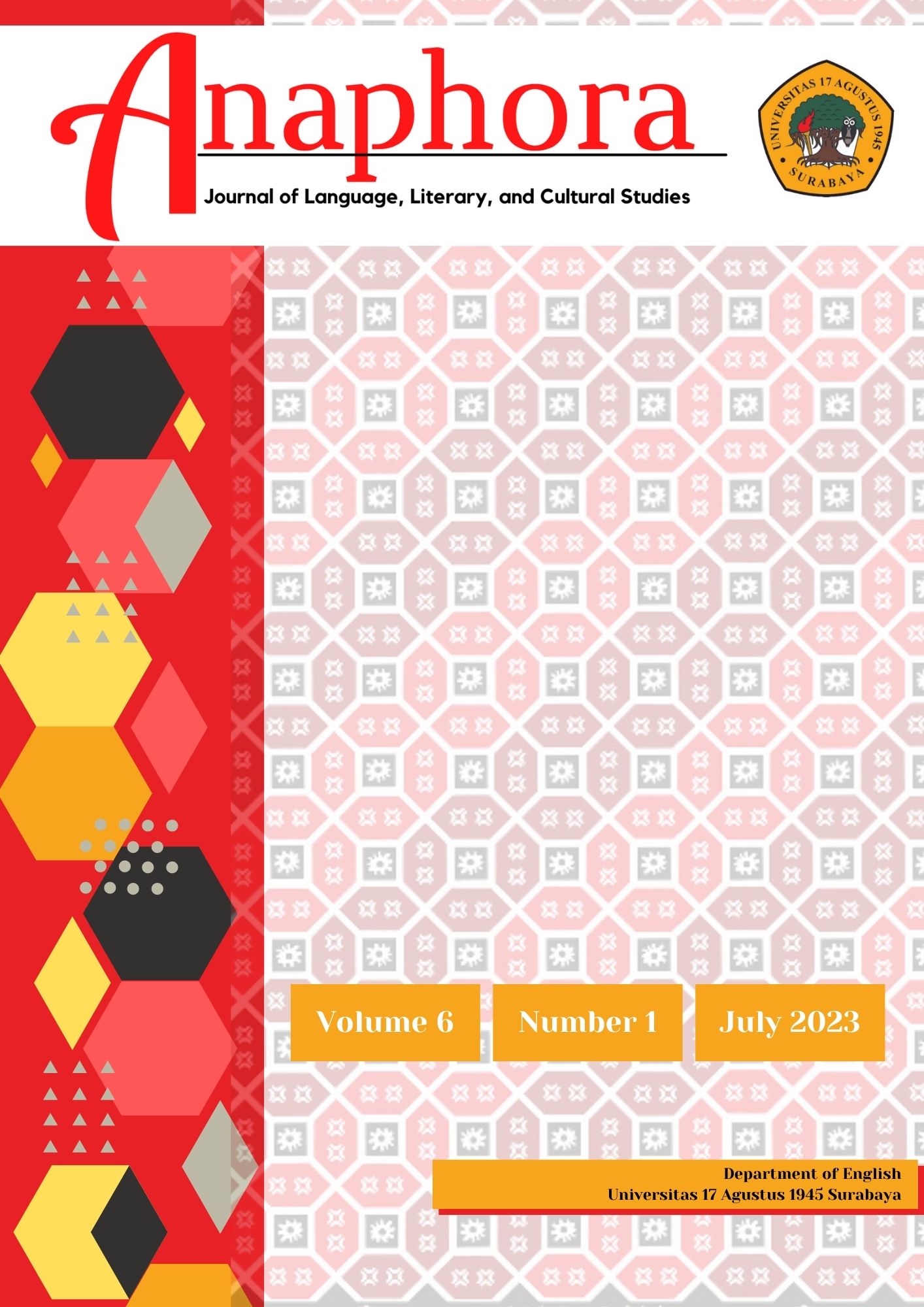Non-EFL Students’ Perception of Grammar and Their Ability in Understanding Basic Grammar
DOI:
https://doi.org/10.30996/anaphora.v6i1.8565Keywords:
basic grammar, grammar, part of speech, students’ ability, students’ perceptionAbstract
This study describes the students’ perception of grammar and to know their ability in understanding basic grammar. This research is descriptive qualitative. The analysis shows that students like learning English grammar because grammar is a rule or guideline related to English proficiency. But a lot of grammar material must be learned because it is very complicated, complex, and interrelated with other materials. Learning grammar is important for them in mastering writing, speaking, listening, reading, and vocabulary. After learning grammar, the students agree that the lecturer teaches grammar material in a fun way, explains grammar material well accompanied by examples and practice, and then gives assignments as understanding evaluations every meeting. The students can understand grammar lessons in English although the grammar learned in college is more complex than in high school, they do not have any difficulty understanding the material on campus. Grammar helps students to able to communicate orally and written in English better, but they still need to learn more grammar to improve their English skills. However, the result of the tests shows something different from their positive perceptions after learning grammar. The average score is 66.86 from 100 points, the median is 71 from 100 points, and the range from the lowest score of 33 up to 91 points score (correct answer) as the highest score. Further research, of course, still needs to be done to find out the reasons why students' grammar skills show an unsatisfactory average.
Downloads
References
Antika, R., Wahyuni, S., & Melvina. (2020). The Ability of English Department Students’ in Using Adverb Clauses of Time. TELL-US Journal, 6(2), 101–118. https://doi.org/10.22202/tus.2020.v6i2.3597
Arifin, M. N. (2021). The Study of Students’ Mastery In Adjective Phrase At A class Banyuanyar English Center [Undergraduate Paper, Institut Agama Islam Negeri Madura]. https://doi.org/10/Moh%20Nurul%20Arifin_18201401030130_BAB%20V_TBI.pdf.pdf
Chalker, S., & Weiner, E. S. C. (1998). The Oxford Dictionary of English Grammar. Oxford University Press.
Coghill, J., & Magedanz, S. (2003). English Grammar. Wiley.
Dewar, J. M., & Bennett, C. D. (2014). Doing the Scholarship of Teaching and Learning in Mathematics. The Mathematical Association of America.
Dykes, B. (2007). Grammar for everyone: Practical tools for learning and teaching grammar. ACER Press. http://thuvienso.bvu.edu.vn/handle/TVDHBRVT/15156
Effendi, Muh. S. (2017). A Study on Grammar Teaching at an English Education Department in an EFL Context [Undergraduate Paper, Universitas Ahmad Dahlan]. https://www.arcjournals.org/pdfs/ijsell/v5-i1/5.pdf
Fitria, T. N. (2022a). Identifying Grammatical and Mechanical Errors of Students’ Writing: Using “Grammarly” as an Online Assessment. Lingua Didaktika: Jurnal Bahasa Dan Pembelajaran Bahasa, 16(2), 169–184. https://doi.org/10.24036/ld.v16i2.116824
Fitria, T. N. (2022b). Mastering English Grammar for Learners (Menguasai Tata Bahasa Inggris Dasar untuk Pembelajar). Eureka Media Aksara. https://repository.penerbiteureka.com/publications/356882/
Fitria, T. N. (2022c). Non-EFL Students’ Ability in Writing Simple Sentences of Descriptive Paragraphs. JETAL: Journal of English Teaching & Applied Linguistic, 4(1), Article 1. https://doi.org/10.36655/jetal.v4i1.762
Fitria, T. N. (2022d). Pelatihan Tata Bahasa Inggris Dasar (English Basic Grammar) Untuk Pembelajar Pemula di Indonesia. Jurnal Pengabdian Dan Pemberdayaan Masyarakat : ABDAYA, 2(1), Article 1. https://jurnal.lenterah.tech/index.php/abdaya/article/view/135
Komara, C., & Tiarsiwi, F. (2021). Exploring Indonesian EFL Learners’ Perception Of English Learning Grammar. Journal of English Language Teaching and Linguistics, 6(2), 459–470. https://doi.org/10.21462/jeltl.v6i2.564
Kumayas, T., & Lengkoan, F. (2023). The Challenges of Teaching Grammar at the University Level: Learning From the Experience of English Lecturer. Journal of English Culture, Language, Literature and Education, 11(1), 98–105. https://doi.org/10.53682/eclue.v11i1.6058
Ling, Z. (2015). Explicit Grammar and Implicit Grammar Teaching for English Major Students in University. Sino-US English Teaching, 12(8). https://doi.org/10.17265/1539-8072/2015.08.002
Mart, C. T. (2013). Teaching grammar in context: Why and how? Theory and Practice in Language Studies, 3(1), 124–130. https://go.gale.com/ps/i.do?p=LitRC&sw=w&issn=17992591&v=2.1&it=r&id=GALE%7CA351081890&sid=googleScholar&linkaccess=abs
Miles, M. B., Huberman, A. M., & Saldana, J. (2018). Qualitative Data Analysis: A Methods Sourcebook. SAGE Publications.
Mirazna, M. N., & Hikmah, N. (2019). Students Perceptions Toward Grammar in English Classroom. PROJECT (Professional Journal of English Education), 2(5), Article 5. https://doi.org/10.22460/project.v2i5.p682-686
Pazaver, A., & Wang, H. (2009). Asian Students’ Perceptions of Grammar Teaching in the ESL Classroom. Undefined. https://www.semanticscholar.org/paper/Asian-Students%27-Perceptions-of-Grammar-Teaching-in-Pazaver-Wang/f550f2b8911a6d487e6b210422e94cdb7a486ab6
Qodariah, L. (2011). An Analysis on students’ difficulties in learning reported speech: A case study the first year student of MA Pemabungan UIN Jakarta [Undergraduate Paper, UIN Syarif Hidayatullah Jakarta]. https://repository.uinjkt.ac.id/dspace/handle/123456789/3612
Rachmawati, S. A. (2022). Persepsi Mahasiswa Terhadap Pembelajaran English Grammar Pada Mata Kuliah Bahasa Inggris. PROGRESSA: Journal of Islamic Religious Instruction, 6(2), Article 2. https://doi.org/10.32616/pgr.v6.2.422.59-72
Risan, R., Rahman, A., G, H., Nasta, M., & Aziz, A. (2022). Pelatihan Bahasa Inggris (Part of Speech) Bagi Mahasiswa Ikor FIK UNM. Jurnal Abdi Negeriku, 1(1), Article 1.
Robbani, A. D. (2021). The EFL Students’ Perception on Teaching Materials Used in Grammar Course [Undergraduate Paper, Universitas Muhammadiyah Yogyakarta]. https://doi.org/10/Lampiran.pdf
Rossiter, A. (2021). The Importance of Grammar. In Online Submission. https://eric.ed.gov/?id=ED613321
Sandi, K. (2016). An Analysis of Students’ Ability in Using Passive Voice at the Third Grade Students of MAS Kepenuhan (Issue 1) [Journal:eArticle, Universitas Pasir Pengaraian]. https://www.neliti.com/publications/109277/
Saricoban, A., & Metin, E. (2000). Songs, Verse and Games for Teaching Grammar (TESL/TEFL). The Internet TESL Journal, 6(10). http://iteslj.org/Techniques/Saricoban-Songs.html
Subasini, M., & Kokilavani, B. (2013). Significance of grammar in technical english. International Journal of English Literature and Culture, 1(3), 56–58. https://www.semanticscholar.org/paper/Significance-of-grammar-in-technical-english-Subasini-Kokilavani/80ea0475c29149093bd67346825fa110c4dec66f
Suri, E. M. (2022). An Analysis of Students’ Ability in Grammar Mastery of Three English Tenses at the Tenth Grade Students’ of SMKN 5 Padang. Jurnal Pendidikan Dan Konseling (JPDK), 4(6), Article 6. https://doi.org/10.31004/jpdk.v4i6.8879
Wang, F. (2010). The Necessity of Grammar Teaching. English Language Teaching, 3(2), 78–81. https://eric.ed.gov/?id=EJ1081617
Wati, P. (2010). Students’ Ability in Identifying Part of Speech in Reading Descriptive Text at the Second Year of SMPN 4 Rengat Regency of Indragiri Hulu [Undergraduate Paper, Universitas Islam Negeri Sultan Syarif Kasim Riau]. https://repository.uin-suska.ac.id/234/
Yelnim, Y., Kartawijaya, S., & Sherlin, I. (2021). The Ability of The Second Years Students of SMAN 2 Sungai Penuh in Using Question Tags. JURNAL SYNTAX IMPERATIF : Jurnal Ilmu Sosial Dan Pendidikan, 2(1), Article 1. https://doi.org/10.36418/syntax-imperatif.v2i1.71
Young, D. J. (2013). Introducing English Grammar. Routledge.
Downloads
Published
How to Cite
Issue
Section
License
Authors whose manuscript is published will approve the following provisions:
-
The right to publication of all journal material published on the jurnal anaphora website is held by the editorial board with the author's knowledge (moral rights remain the property of the author).
-
The formal legal provisions for access to digital articles of this electronic journal are subject to the terms of the Creative Commons Attribution-ShareAlike (CC BY-SA) license, which means Jurnal Persona reserves the right to store, modify the format, administer in database, maintain and publish articles without requesting permission from the Author as long as it keeps the Author's name as the owner of Copyright.
-
Printed and electronic published manuscripts are open access for educational, research and library purposes. In addition to these objectives, the editorial board shall not be liable for violations of copyright law.















